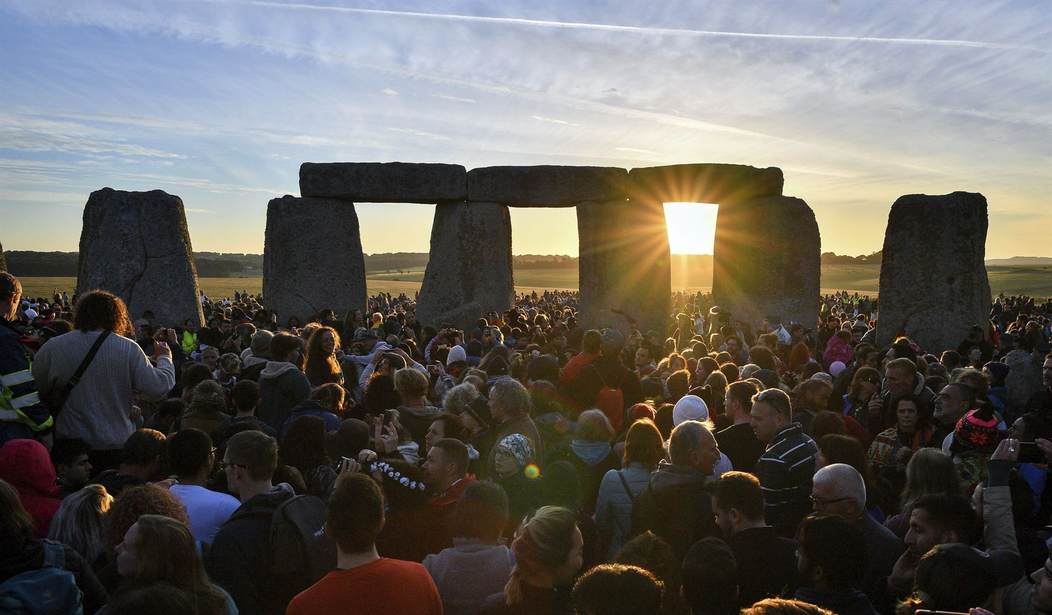It is not a tremendous distance from Stonehenge to Canterbury -- less than 150 miles by modern roads -- but these two locations in southern England mark a tremendous advancement in the art of architecture.
Stonehenge is a simple, rough-hewn structure with a design dictated by the sun.
"Stonehenge was carefully designed to align with the movements of the sun," Dr. Susan Greaney, an historian for English Heritage, explains in an essay posted on the British Museum website. "The enormous sarsen stones and smaller bluestones, set up in the centre of the site in about 2500 BC, were precisely arranged to frame two particular events in the year: the sunrise at summer solstice, and the sunset at winter solstice."
"It is likely that people gathered at Stonehenge at the summer and winter solstices to witness the pivotal changes in the movement of the sun, and to conduct rituals and ceremonies relating to the changing seasons, the sun and the sky," says Greaney.
When my daughter and I visited Stonehenge on the Sunday before the solstice, I was surprised by how small it seemed in person. From the photographs and videos I had seen of this place, I expected a much grander structure.
While not as tall and wide as I expected, Stonehenge is still impressive in the sense that it illustrates that prehistoric peoples found a way to move massive stones a great distance and then erect them into an orderly monument that has lasted millennia.
It also attracts a large number of tourists. In the pre-pandemic year of 2019, according the stonehengevisit.co.uk website, it "saw a peak in visitors of 1.6 million."
Recommended
Drive from Stonehenge to Canterbury and you can visit a religious site that is about 3,000 years younger than that prehistoric ring of stones. It is Canterbury Cathedral.
A timeline on the cathedral's website says that St. Augustine first established a cathedral at Canterbury in 597. Roman Catholic Archbishop Lanfranc -- who came to England in the wake of William the Conqueror -- rebuilt the cathedral from 1070-1077. From 1098-1130, a new quire was built in the back of the cathedral; and from 1175-1184, according to the website, the quire was rebuilt following a fire.
From 1377-1405, the nave built by Archbishop Lanfranc was replaced with a new one; and, in 1498, according to the timeline, the bell tower at the back of the church was "extended" and the cathedral was "largely complete as seen today."
This medieval monument is still magnificent. Its carefully carved stone walls stand in perfect symmetry. Its elegant bell towers reach to the sky.
And the place within it where St. Thomas Becket was martyred remains a place of pilgrimage.
In 1161, when Archbishop Theobald of Canterbury passed away, a monk predicted to Becket -- who was then serving as Lord Chancellor to King Henry II -- that he would likely be named the archbishop's successor. Becket was wary of that possibility.
According to the biography that Jesuit Father John Morris published in 1885, Becket told this monk: "I know three poor priests in England, any one of whom I had rather see promoted to the archbishopric than myself; for I know my lord the King so intimately, that I am sure I should have to choose between his favour and that of Almighty God, if I myself were to be appointed."
Becket's premonition was correct.
In 1170, as Becket refused to surrender the authority of the church to the king, Henry II expressed his disgust with the then-Archbishop of Canterbury in front of four of his knights. "What slothful wretches I have brought up in my kingdom, who have no more loyalty to their King than to suffer him to be so disgracefully mocked by this low-born cleric!" said the monarch (as reported in Father Morris' biography).
On hearing this, the four knights set off for Canterbury and confronted Becket near the very heart of the cathedral. He refused to back down. They martyred him.
As St. Thomas lay dying on the cathedral floor, he spoke these last words: "For the Name of Jesus, and the defense of the Church, I am ready to die."
Two centuries later, Geoffrey Chaucer memorialized in "The Canterbury Tales" how medieval men and women pilgrimaged to the site of Becket's martyrdom.
In the introduction to these tales, Chaucer wrote: "And specially from every shire's ende/Of Engelond to Caunterbury they wende/The hooly blissful martir for to seke."
Pilgrims still make their way to that very place.
Back in London, along the River Thames, is the White Tower that William the Conqueror erected as the first building in what would become the Tower of London. In 1535, St. Thomas More and St. Cardinal John Fisher were martyred by the tyrannical Henry VIII on the adjacent Tower Hill.
Just a short distance from the Tower there now stands a sheer steel and glass high-rise building -- erected in this century -- that seems to defy nature by widening out as it reaches up.
Will people come to that building in the centuries ahead to see a lasting masterpiece? No.
But they will still venerate the places were St. Thomas Becket, St. John Fisher and St. Thomas More became martyrs for their faith.

























Join the conversation as a VIP Member